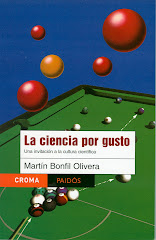Published in Milenio Diario, October 28th, 2009
 Each year, in October, science popularizers get our busiest season, because that's when the national Science and technology week is held in Mexico.
Each year, in October, science popularizers get our busiest season, because that's when the national Science and technology week is held in Mexico.
As a matter of fact, the demand for all kinds of activities –conferences, courses, workshops, expositions, science fairs, concerts, starry nights, contests…- its such that many states opt to enlarge it, turning it into the Month of Science and Technology – and some, into several months! – so competition is not that intense.
The event, promoted and organized by the National Council for Science and Technology (Conacyt), has for 16 years placed scientific culture in the reach of literally millions of kids, youngsters and adults all over the country.
This year the national venue was the state of
But is it worth it, with all the economic crisis and our country's problems, to spend budget and work in such an event? Here are four good reasons to do it:
-Because the standard of life in a country depends strongly on the size of its scientific-technological-industrial apparatus. An good-sized, active scientific community detonates the production of original knowledge which become technology and patents that can make a modern and powerful nation. Think of the Korean cell phones, Indian cars and Chinese computers we import, or of the Brazilian technology for oil extraction that we're far of matching. And the first step is to awaken scientific vocations in kids and young people (and of course, to give them jobs in research institutes, but that's another story).
-Because the scientific way of thinking is a powerful tool in fighting harmful beliefs, such as the conspiracy theories that deny the seriousness of the influenza pandemia and the usefulness of vaccines in preventing infection.
-Because if the citizens do not understand the science behind matters such as cloning, euthanasia, transgenic crops or stem-cell research, they cannot take part in the decisions we as a society need to take.
-Because science and technology, as products of human creativity, are and endless source of amazement and great ways of having a great time. All citizens have the right to enjoy them.
For these, and many other reasons, long live the Science and Technology Week! I only wish it could last all year long.
(translated by Adrián Robles Benavides) To receive Science for pleasure weekly
in your email, subscribe here!







